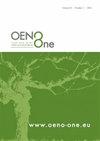UV-C-induced changes in a white wine: Evaluating the protective power of hydrolysable tannins and SO2
IF 2.2
3区 农林科学
Q3 FOOD SCIENCE & TECHNOLOGY
引用次数: 0
Abstract
UV‑C treatment is a non-thermal technology that could be used for the microbiological stabilisation of must and wine. However, light - in this case UV‑C light - has an impact on wine. UV‑C is a high-energy light source and can promote photo-induced oxidation reactions. The formation of reactive oxygen species during the UV-C treatment of wine can be prevented via supplementation with antioxidants. These have the ability to neutralise reactive oxygen species or directly interact with the products of photo-induced oxidation reactions. This study investigates the impact of different UV‑C doses on the chemical and sensory characteristics of Chardonnay wine and examines the protective effect of two antioxidants: sulphur dioxide (SO2) and hydrolysable tannins. A sensory evaluation revealed that UV‑C doses higher than 1 kJ/l increased the colour intensity and the oxidised and burnt odour attributes of the wine. The peach odour attribute decreased with UV‑C treatment. On a chemical level, increasing UV‑C doses promoted the formation of compounds such as acetaldehyde and 2‑aminoacetophenone (2‑AAP), while causing the degradation of C13‑norisoprenoids, higher alcohols, monoterpenes and esters. Contrary to expectations, SO2 did not act as an antioxidant when wine was treated with UV-C. It intensified the burnt odour attribute and did not mitigate the intensity of the oxidised odour attribute, which can be explained by the formation of acetaldehyde. However, hydrolysable tannins acted as antioxidants when combined with UV‑C treatment, effectively mitigating the formation of 2‑AAP and acetaldehyde, while preventing the wine from becoming oxidised.紫外线诱导的白葡萄酒变化:评估可水解单宁和二氧化硫的保护能力
紫外线-C 处理是一种非热处理技术,可用于葡萄汁和葡萄酒的微生物稳定。然而,光(这里指 UV-C 光)对葡萄酒有影响。紫外线-C 是一种高能光源,可促进光诱导氧化反应。可以通过补充抗氧化剂来防止葡萄酒在紫外线-C 处理过程中形成活性氧。抗氧化剂具有中和活性氧或直接与光诱导氧化反应产物相互作用的能力。本研究调查了不同紫外线-C 剂量对霞多丽葡萄酒化学和感官特性的影响,并检验了两种抗氧化剂:二氧化硫(SO2)和可水解单宁的保护作用。感官评估显示,紫外线 C 剂量高于 1 kJ/l 会增加葡萄酒的颜色强度以及氧化和焦味属性。桃子气味会随着紫外线-C 处理的增加而减少。在化学层面上,紫外线-C 剂量的增加促进了乙醛和 2-氨基苯乙酮(2-AAP)等化合物的形成,同时导致了 C13-异戊烯、高级醇、单萜烯和酯的降解。与预期相反,用紫外线-C 处理葡萄酒时,二氧化硫并没有起到抗氧化剂的作用。它加剧了焦味,但并没有减轻氧化味的强度,这可以用乙醛的形成来解释。然而,可水解单宁在与紫外线-C 处理相结合时起到了抗氧化剂的作用,有效缓解了 2-AAP 和乙醛的形成,同时防止了葡萄酒氧化。
本文章由计算机程序翻译,如有差异,请以英文原文为准。
求助全文
约1分钟内获得全文
求助全文
来源期刊

OENO One
Agricultural and Biological Sciences-Food Science
CiteScore
4.40
自引率
13.80%
发文量
85
审稿时长
13 weeks
期刊介绍:
OENO One is a peer-reviewed journal that publishes original research, reviews, mini-reviews, short communications, perspectives and spotlights in the areas of viticulture, grapevine physiology, genomics and genetics, oenology, winemaking technology and processes, wine chemistry and quality, analytical chemistry, microbiology, sensory and consumer sciences, safety and health. OENO One belongs to the International Viticulture and Enology Society - IVES, an academic association dedicated to viticulture and enology.
 求助内容:
求助内容: 应助结果提醒方式:
应助结果提醒方式:


